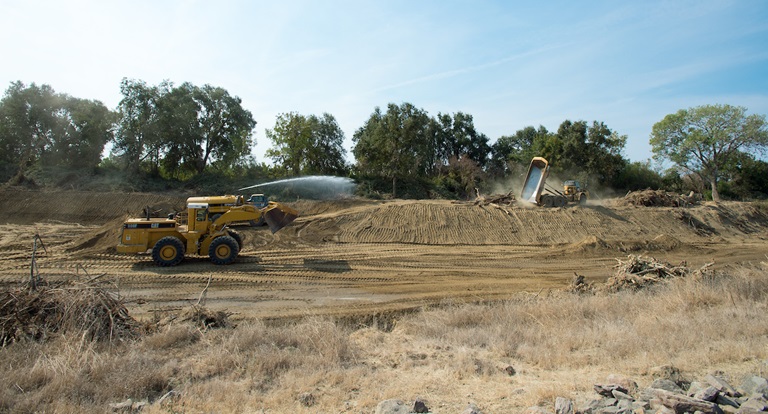Reducing Flood Risk on Elder Creek
Work on the Elder Creek Channel in Tehama County. 
The Department of Water Resources (DWR) is completing the second year of the Elder Creek Channel Rehabilitation Project. The five-year project will clear sedimentation and vegetation to restore flow capacity of a four-mile stretch of the state-maintained Elder Creek in Tehama County.
With a goal of clearing approximately one mile per year, the project reduces flood risk for the nearby town of Gerber and surrounding farmland, which includes fruit and nut orchards.
“This project highlights DWR’s mission of providing public safety and environmental protections in flood management,” said Scott Deal, DWR’s Chief (acting) of Flood Maintenance Office. “It contributes to the implementation of the Central Valley Flood Protection Plan by maintaining a functional flood system.”
The estimated flow of the channel’s flood control capacity has been limited in recent years, due to growth of the invasive Arundo and accumulated sediment. For more than a decade, hand crews tried to maintain the channel but could not keep up with the rapid growth of the Arundo.
Thanks to additional funding provided by Proposition 1E and DWR’s Flood Maintenance Office, DWR can now use both hand crews and equipment to perform the required maintenance that will bring the area back into compliance with the U.S. Army Corps of Engineers’ 1957 design profile capacity, a federal flood standard.
Upon project completion, the capacity will be restored to 17,000 cubic feet per second (cfs), almost double the 9,000 cfs capacity of the channel before the project started.
As of spring 2019, DWR completed about one and one-half miles of restoration and removed approximately 50,000 cubic yards of sediment and approximately two acres of vegetation. Because of this removal, the area is already starting to see improved flow during high-water events.
DWR is committed to minimizing environmental impacts when designing flood management projects. This project was originally set to move 308 elderberry shrubs which are a host for the endangered Valley Elderberry Longhorn Beetle. DWR modified the design to remove only 18 elderberry shrubs, which were transplanted to a mitigation bank approved by the U.S. Fish and Wildlife Service.
DWR conducts pre-construction nest surveys to make sure sensitive species and habitats are not disrupted. If these species are found, the Department conducts project activities in designated work windows and establishes buffers. DWR also adjusts removal methods if sensitive species are found. For example, when Arundo is found near elderberry bushes, hand crews remove the invasives instead of machinery or herbicides.
DWR is gearing up for year three of the project. The Department plans to perform all required biological and environmental preconstruction surveys and acquire all needed supplies and equipment to conduct activities scheduled for this summer. Due to high rain fall, sediment will not be removed this year because there is still active water in the channel, which creates safety concerns.
“This is a fun project to work on,” said Gabrielle Tomblin Bohrer, DWR environmental scientist and project environmental lead. “There have been so many moving parts, from rare plant finds to engineering project redesigns to reducing environmental impacts and construction constraints. Personnel have been able to maneuver through it all. It’s been great to work with a diverse group of people and see everyone’s hard work come to life.”
The Elder Creek project is part of the federal Sacramento River Flood Control Project, which provides flood protection to the town of Gerber, adjacent roads, railroads, buildings, and agricultural lands.
